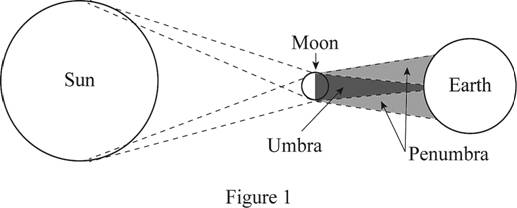
Concept explainers
To explain: The reason why the moon’s shadow has a dark center surrounded by a region of increasing brightness.
Answer to Problem 1CQ
The reason why the moon shadow has a dark center surrounded by a region of increasing brightness is been explained.
Explanation of Solution
During the solar eclipse, the moon comes in between the sun and the Earth. The rays coming from the sun will strike the moon’s surface and form a region of dark circle in the Earth’s surface called umbra as shown in Figure 1.

Some part of the rays strikes the moon and reaches the Earth’s surface causing dark spots (umbra). The other rays coming from the sun will not be blocked by the moon and form bright spots (penumbra) on the Earth’s surface.
Conclusion:
Thus, the reason why the moon shadow has a dark center surrounded by a region of increasing brightness is been explained.
Want to see more full solutions like this?
Chapter 18 Solutions
COLLEGE PHYSICS (LL)W/MOD.MASTERINGPHYS
- A 4.00-m-long pole stands vertically in a freshwater lake having a depth of 2.00 m. The Sun is 40.0 above the horizontal. Determine the length of the poles shadow on the bottom of the lake.arrow_forwardWhat happens to a light wave when it travels from air into glass? (a) Its speed remains the same. (b) Its speed increases. (c) Its wavelength increases. (d) Its wavelength remains the same. (e) Its frequency remains the same.arrow_forwardCan a fire have shadow? Explain your answer.arrow_forward
- Chapter 25: Problem 5: In the year 1178, five monks at Canterbury Cathedral in England observed what appeared to be an asteroid colliding with the moon, causing a red glow in and around it. It is hypothesized that this event created the crater Giordano Bruno, which is right on the edge of the area we can usually see from Earth. a) How long after the asteroid hit the Moon, which is 3.84 ×10⁵ km away, would the light first arrive on Earth in seconds?arrow_forward____9. There are seven members of electromagnetic radiation family.____10. EM waves are composed of oscillating magnetic and electric fields.____11. When light moves from one medium to another, it normally diffract.____12. The angle of incidence θi is equal to the angle of reflection θr according to Snell’s Law.arrow_forwardSunlight or starlight passing through the earth’s atmosphere is always bent toward the vertical. Why? Does this mean that a star is not really where it appears to be? Explain.arrow_forward
- Can air make shadows? Explain it.arrow_forward13. (4 marks) While performing a series of tests on an unknown substance, a lab determines that it has an index of refraction of 2.35. What is the speed of light inside this substance?arrow_forwardOn a sunny summer day, with the sun overhead, you can stand under a tree and look on the ground at the pattern of light that has passed throughgaps between the leaves. You may see illuminated circles of varying brightness. Why are there circles, when the gaps between the leaves have irregular shapes?arrow_forward
- HW7 Q10 A submerged scuba diver looks up toward the calm surface of a freshwater lake and notes that the Sun appears to be 31 degrees from the vertical. The diver's friend is standing on the shore of the lake.arrow_forwardAs a result of his observations, Ole Roemer concluded that eclipses of Io by Jupiter were delayed by 22 min during a six-month period as the Earth moved from the point in its orbit where it is closest to Jupiter to the diametrically opposite point where it is farthest from Jupiter. Using the value 1.50 × 108 km as the average radius of the Earth’s orbit around the Sun, calculate the speed of light from these data.arrow_forward113. A light ray strikes a flat piece of glass at an angle of incidence 60°. The index of refraction of the glass is 1.5. The thickness of the glass is 2 cm. Trace the light ray until it emerges from the glass. 609 Air Glassarrow_forward
 Principles of Physics: A Calculus-Based TextPhysicsISBN:9781133104261Author:Raymond A. Serway, John W. JewettPublisher:Cengage Learning
Principles of Physics: A Calculus-Based TextPhysicsISBN:9781133104261Author:Raymond A. Serway, John W. JewettPublisher:Cengage Learning Physics for Scientists and Engineers: Foundations...PhysicsISBN:9781133939146Author:Katz, Debora M.Publisher:Cengage Learning
Physics for Scientists and Engineers: Foundations...PhysicsISBN:9781133939146Author:Katz, Debora M.Publisher:Cengage Learning College PhysicsPhysicsISBN:9781938168000Author:Paul Peter Urone, Roger HinrichsPublisher:OpenStax College
College PhysicsPhysicsISBN:9781938168000Author:Paul Peter Urone, Roger HinrichsPublisher:OpenStax College College PhysicsPhysicsISBN:9781285737027Author:Raymond A. Serway, Chris VuillePublisher:Cengage Learning
College PhysicsPhysicsISBN:9781285737027Author:Raymond A. Serway, Chris VuillePublisher:Cengage Learning Physics for Scientists and Engineers, Technology ...PhysicsISBN:9781305116399Author:Raymond A. Serway, John W. JewettPublisher:Cengage Learning
Physics for Scientists and Engineers, Technology ...PhysicsISBN:9781305116399Author:Raymond A. Serway, John W. JewettPublisher:Cengage Learning College PhysicsPhysicsISBN:9781305952300Author:Raymond A. Serway, Chris VuillePublisher:Cengage Learning
College PhysicsPhysicsISBN:9781305952300Author:Raymond A. Serway, Chris VuillePublisher:Cengage Learning





